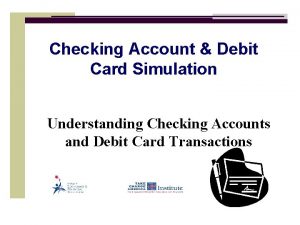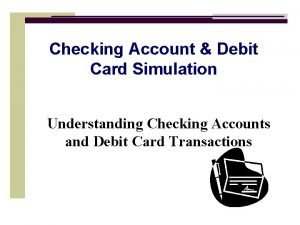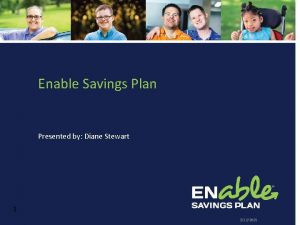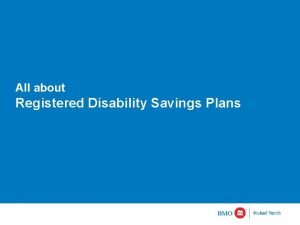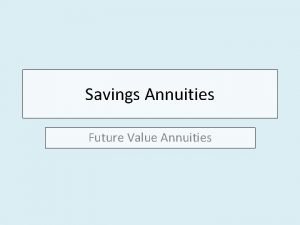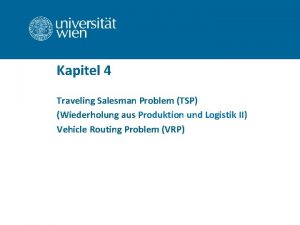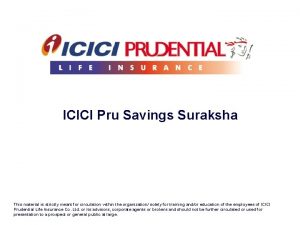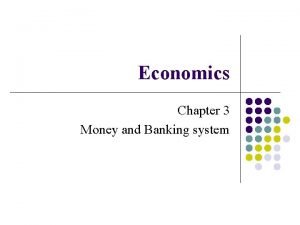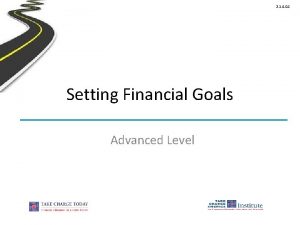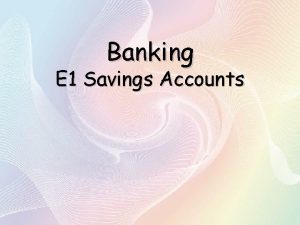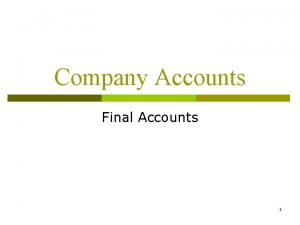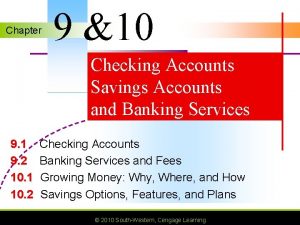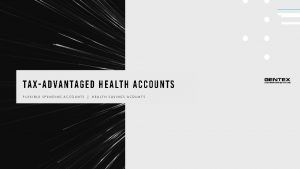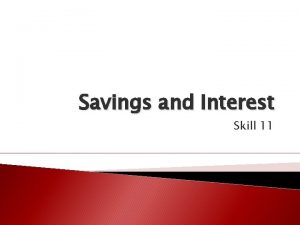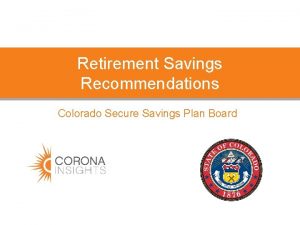Savings Accounts Savings Plans Savings Plan is a




















- Slides: 20

Savings Accounts & Savings Plans

Savings Plan is a strategy for using money to reach important goals and to advance your financial security. Budgeting for Saving Create an Emergency Fund Setting Goals for Saving

Budgeting for Saving Pay Yourself First Set aside money for savings before bills and expenses are paid. Put Use savings into your spending plan. Direct Deposit Automatically Let put money into savings account Your Savings Grow Leave it alone; Only use Checking Account for spending. Reduce Spending; Increase Saving

Create Emergency Fund An Emergency Fund is an amount of money you can easily access in case of: Job Layoff Illness Unexpected The Expense (car repair, repair on house, etc. ) Emergency Fund should cover living expenses for 6 to 8 months.

Set Goals for Saving After you have an Emergency Fund, set aside financial goals. SMART Goals Specific Measurable Achievable Realistic Time Related

SMART Goals

Smart Goals - Examples Joe is 16 years old and wants to buy a used car when he turns 18. The car he wants is $5, 000. He has 2 years to save. He needs to save $210 a month. Mike is 20 years old and wants to buy a house when he turns 30. The A house is listed at $300, 000. 15% down payment will cost him $45, 000 (. 15 x 300, 000). He needs to save $4, 500 a year or $375 a month. Create Each another example with a partner. group will present their SMART Goal to the class.

Saving Plan Tools and Calculators http: //www. forefieldkt. com/axa_java_tools/dt_trns. aspx? xd=Rollover 401 k&il =ax https: //us. axa. com/goals/retirement-planning/calculator. html http: //www. bloomberg. com/personal-finance/calculators/401 k/ https: //www. expertplan. com/faq 401 k/faq_distributions. jsp

Savings Accounts Savings Account is an account designed for accumulating money for future use. Many similarities and differences among savings accounts. 1. Minimum amount required to open the account 2. Interest Rate (APR vs. APY) 3. Minimum deposit and time requirements 4. Fees, Conditions, and Penalties

Interest Rates Annual Percentage Rate (APR) Actual DOES interest rate calculated yearly NOT Compound (earns the same rate over time) Annual Percentage Yield (APY) Rate of return on interest Compounds APY interest (Interest earned on Interest) is typically higher and more relevant

Types of Savings Accounts 1. Interest Bearing Savings Accounts Ø Online-Only Savings Accounts 2. Money Market Accounts 3. Certificate of Deposit Accounts (CD’s) 4. US Savings Bonds

Interest-Bearing Savings Accounts are traditional savings accounts that pay interest on the balance. Allows No regular/anytime deposits and withdrawals. set maturity date Close the account whenever you choose Fixed interest rate Very Liquid (cash is easily accessible) Insured by FDIC

Interest-Bearing Savings Accounts Online-Only Provide Savings Accounts – (Internet Banks) banking services ONLY online. Customers use the bank’s website to make: Electronic Transfer Check Internet Offer Deposits and Withdrawals Funds Account Balances Banks have minimal operating costs Higher Interest Rates

Money Market Accounts Money Market Account Intro Video Money Market Accounts - savings account that typically pays a higher interest rate than regular savings accounts. Combines Higher Checking and Savings Accounts minimum deposit/balance (usually at least $500) Offers low-risk investments Tiered or Variable Interest Rates (moves up or down) Mid-High Insured Liquidity by FDIC

Certificate of Deposit (CD) CD Intro Video A Certificate of Deposit (CD) is a savings account that requires a fixed deposit amount for a fixed period of time or term. Also 1 called Time Deposit or Time Account month to 10 years (usually 2 -5 years) Minimum Low-risk Penalty Low deposit usually $1, 000 investment for early withdrawal Liquidity (depends on length of term) Insured by FDIC

Certificate of Deposit Money is ONLY available after it matures: Maturity Date is when the term ends and the money is accessible. Once the CD matures you may: Keep your money in the CD Deposit into another CD Take out the money Higher Interest Rates than Money Market and Regular Savings Accounts: Fixed Interest Rate (Stays the same) The longer the term, the higher the interest rate For Example; 5 Year CD – 4% Interest: 2 Year CD – 2% Interest

US Savings Bonds “Buy” a Savings Bond electronically from Department of Treasury. Lending $25 Min; Up to $10, 000 Earns Up interest for a set period of time. to 30 years Penalties Before After Very for early redemption 5 years – Forfeit 3 months interest 5 years – No Penalty Low Liquidity Insured Very money to the Federal Government by US Government Low/No Risk - Safest form of Savings/Investment

US Savings Bonds Two Types: Series EE Bonds Series I Bonds EE Bonds - low-risk savings product that earns a fixed interest rate of 0. 10%. Compounded Guaranteed Before to Double in value after first term (20 yrs). 2005 – Variable Interest Rates Paper After monthly Bonds - Sold at 50% of Face Value (Pay $25 for $50) 2005 – Fixed Interest Rates Electronic Bonds – Sold at Face Value (Pay $25 for $25)

US Savings Bonds I Bonds Low-risk savings product that earns a combined: 1. Fixed Interest Rate Life 2. of the Bond Variable Inflation Rate Compounded Adjusted every 6 months Semiannually (May & November) Composite (or combined) Interest Rate: Currently Sold 1. 64% at Face Value (Pay $50 for $50)

Calculate Bond value - http: //www. treasurydirect. gov/BC/SBCPrice
 Chapter 5 savings accounts
Chapter 5 savings accounts 2-3 savings accounts answers
2-3 savings accounts answers 3-1 savings accounts worksheet answers
3-1 savings accounts worksheet answers 3-1 savings accounts worksheet answers
3-1 savings accounts worksheet answers Chapter 30 savings accounts
Chapter 30 savings accounts Texas 529 plans
Texas 529 plans Dreamahead college investment plan
Dreamahead college investment plan Enable savings plan
Enable savings plan Registered disability savings plan bmo
Registered disability savings plan bmo Montana 529 plan
Montana 529 plan Geothermal cost savings calculator
Geothermal cost savings calculator Annuity formula
Annuity formula 2 opt verfahren
2 opt verfahren Savings account java
Savings account java Icici pru savings suraksha
Icici pru savings suraksha Retirement savings percentile
Retirement savings percentile 3 tier banking system
3 tier banking system Directions to 529
Directions to 529 A measurable savings goal spells out ________.
A measurable savings goal spells out ________. Interior savings million dollar bursary
Interior savings million dollar bursary Crpc
Crpc


